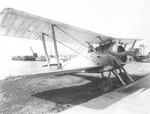| Click On Image For Full Size Image |
Size | Image Description | Contributed By And/Or Copyright |
|
|---|---|---|---|---|
 |
344k | A photo of Hanriot HD-2 refurbished by the Naval Aircraft Factory as a HD-1 for use in the battleship fly-off platform program appears in the thumbnail on the left. Note the hydrovane below the engine cowl and the inflatable pontoons attached to the lower wing. The Hanriot HD-1 was introduced in the spring of 1917 but was not accepted by the French Aviation Militaire, which was in the process of rearming its Scout squadrons with the SPAD S.VII. Choosing to give its own squadrons first priority in assignment of SPAD VII, the French government allowed Hanriot to sell the HD-1 to Belgium and Italy, which needed to replace their now outclassed Nieuports, while the newly arrived Americans were outfitted with the Nieuport 28. The French Aviation Maritime used a few as well. The French Navy operated a Naval Air Station at Dunkerque (also spelled Dunkirk) flying Donnet-Denhaut and Tellier flying boats on anti-submarine patrols over the English Channel and the southern North Sea. Being so close to the front lines (less than 15 miles), the base was the occasional recipient of shelling as well as air raids. Also, Ostend was the home of the Hansa-Bandenburg W series seaplane fighters operated by the Germany Navy, which proved very hazardous to the French patrol planes. In 1916 the French Navy, lacking any seaplane fighter designs purchased a small number of Sopwith Babies from the RNAS and enlisted Hanriot to license build more. By 1917 a more advanced fighter was needed and the Navy requested Hanriot create a seaplane version of the Hanriot HD-1. Hanriot increase the rudder area, added twin pontoons in place of the wheeled undercarriage and a more powerful engine to create the Hanriot HD-2. The First Aeronautical Detachment USN arrived in France in June of 1917 and by September the decision was made to establish 11 Naval Air Stations along the northern coast of France that to be operated by the US Navy, three of which Paimboeuf, Moutchic and Dunkerque, were existing stations operated by the French Navy which were to be turned over to the USN. Additionally the Donnet-Denhaut and Tellier patrol plane were to be given over until US replacements could arrive. Lt. Kenneth Whiting, commanding the Detachment, refused to accept NAS Dunkerque unless fighters were provided. Thus the US Navy acquired its first fighter aircraft with the purchase of 26 Hanriot HD-2s. (See Note) These fighters operated as cover for the patrol flying boats typically 2 fighters per patrol aircraft. The Navy operated these aircraft from Dunkerque through the end of the war. At least 10 of them were then shipped back to the US. After the war, experiments with launching land based fighters from a platform built atop a main battery turret lead to the conversion of the Hanriot HD-2s brought back from Europe into HD-1 configuration by the Naval Aircraft Factory. Eventually, the US Navy equipped all of the existing 14” gunned battleships: New York class (BB-34 / 35), Nevada class (BB-36 / 37), Pennsylvania class (BB-38 / 39) and New Mexico class (BB-40 / 42); the California class (BB-43 / 44) were not commissioned until after the fly-off program had been dropped) with these platforms. The US Navy improved the survivability of the aircraft when making water landings by adding a horizontal vane, attached to the undercarriage at the same level as the axle and extended forward to below the engine. When the undercarriage struck the water this vane would plane across the surface and bear the weight of the engine thus preventing the aircraft from pitching nose down. In addition the US Navy added 2 inflatable floats to the underside of the lower wing and extending forward about as far as the hydro-vane. By 1920, due to the limited numbers of the HD-1s and wear and tear on the airframes, these aircraft were replaced by Nieuport 28’s and Sopwith 1-1/2 Strutters that were obtained from the US Army. Note: Most sources claim that the US Navy purchased a total of only 10 Hanriot HD-2s. This is based on the fact that only 10 Hanriots were assigned Bureau of Aeronautic serial numbers (A5620 through A5629). The error here is that the BurAero “A” serial numbers were not created until 1920 and were only assigned to aircraft still in inventory at that time. Therefore all the aircraft used during the war especially those supplied by the French and British governments but were war casualties or returned after the war would not have been assigned serial number under this system. All other sources set the number of Hanriots operated by the USN at NAS Dunkerque at 26. SPECIFICATIONS: Crew: 1 Length: (HD-1) 19’ 2” (HD-2) 23’ 0” Wing Span: 27’ 11” Wing Area: 198 Sq. Ft. Height: 10’ 2” Weight: Empty: 1092 lbs. Gross: 1540 lbs. Max. Speed: 113 mph Range: 186 miles Ceiling: 15,750 ft. Armament: 1 or 2 Vickers MG Engine: Clerget 9B 130 hp. | Text courtesy of Chris Hoehn. Photographs courtesy of flightglobal.com., wikiperia.com, usaww1.com & Chris Hoehn. | |
| Back To US Battleship Construction Index | Back To The Main Photo Index | Back To The Battleship Photo Index Page |
This page is created by Chris Hoehn and Michael Mohl & maintained by Michael Mohl
All Pages © 1996 - 2025, by Paul R. Yarnall NavSource Naval History. All Rights Reserved.